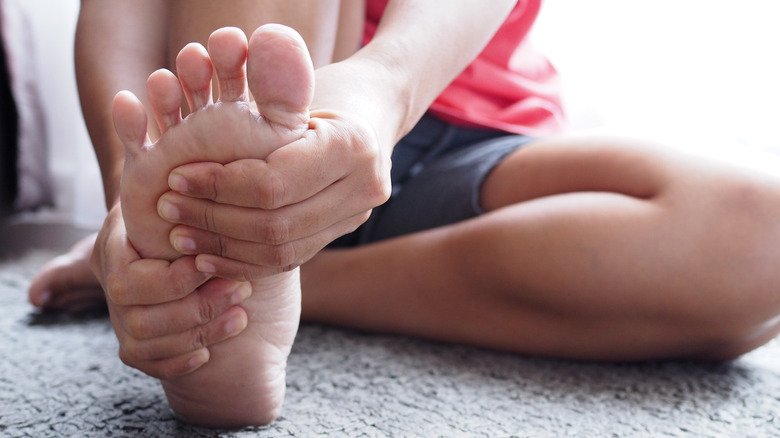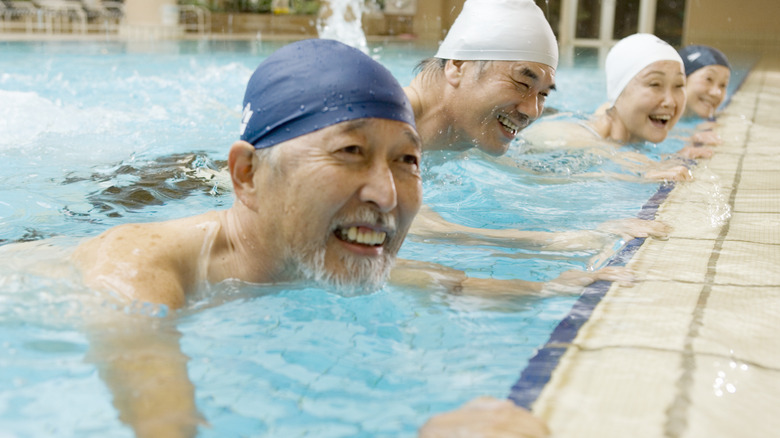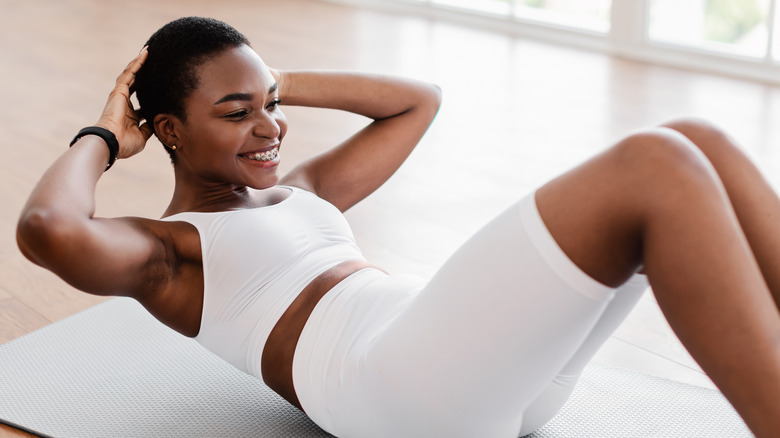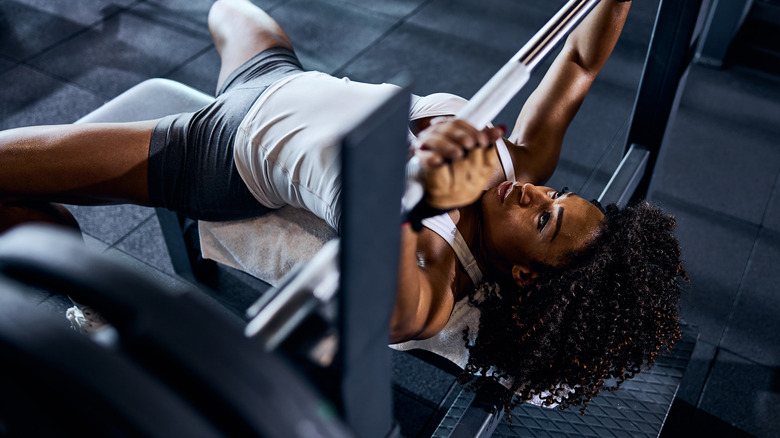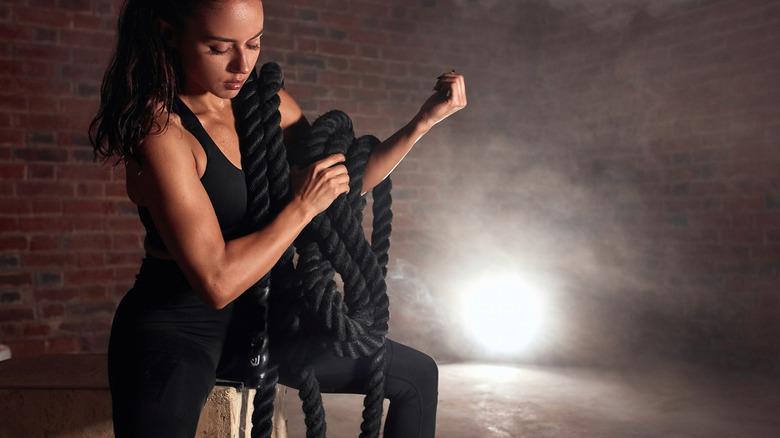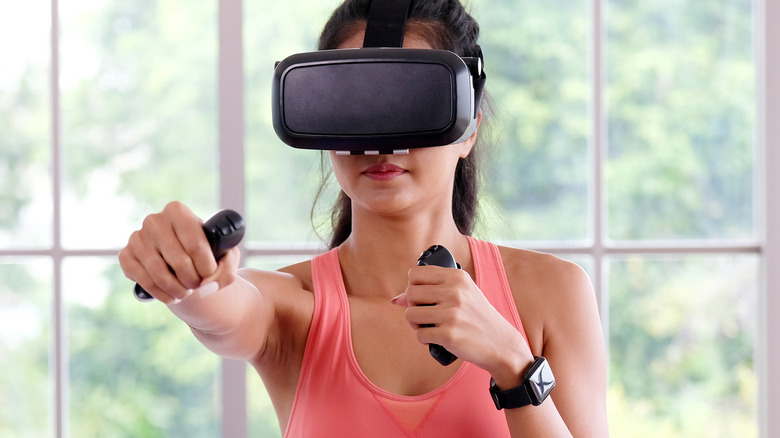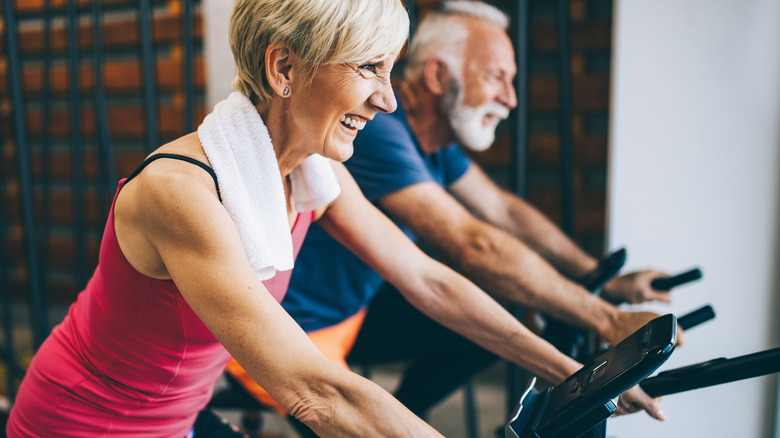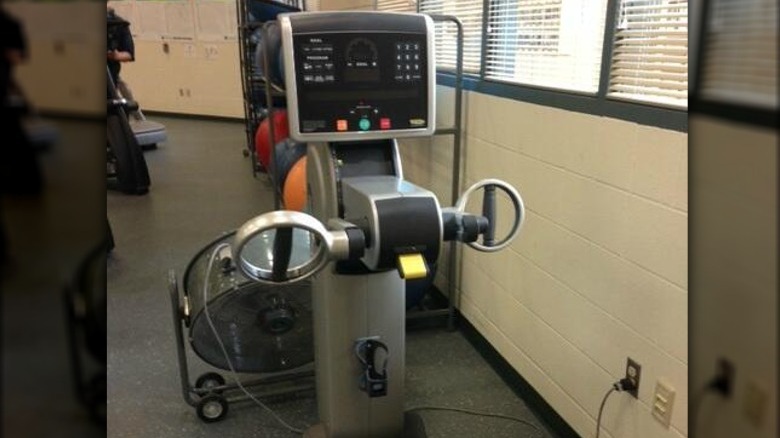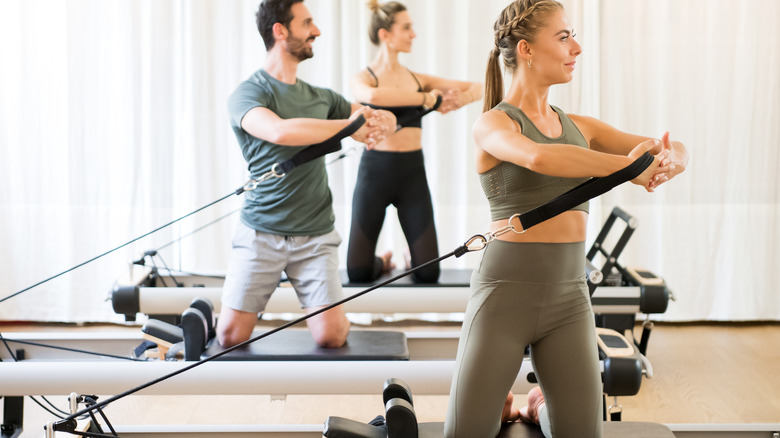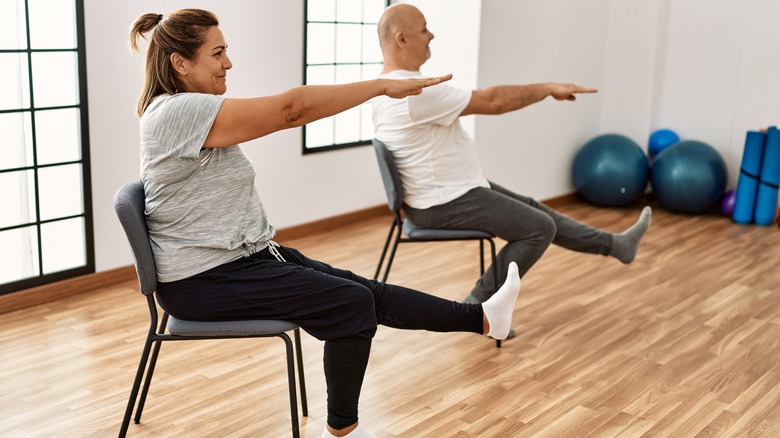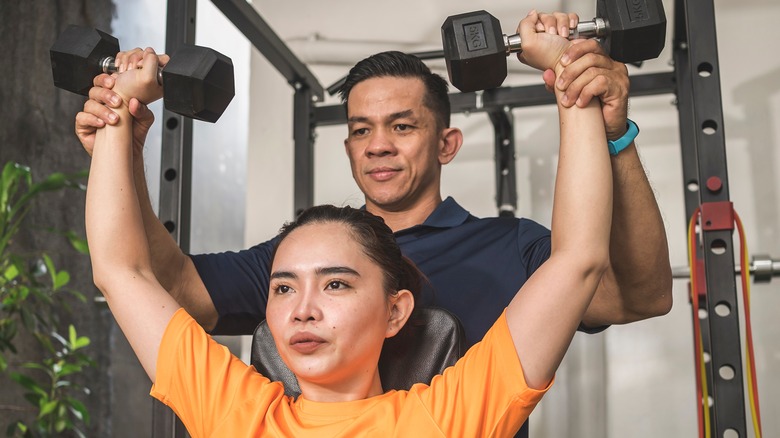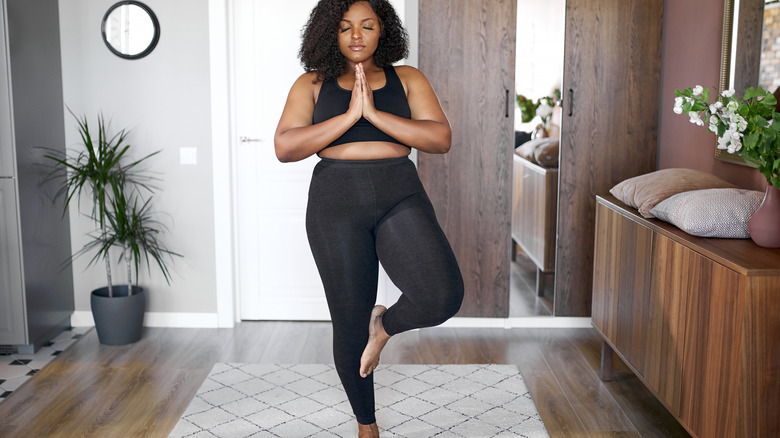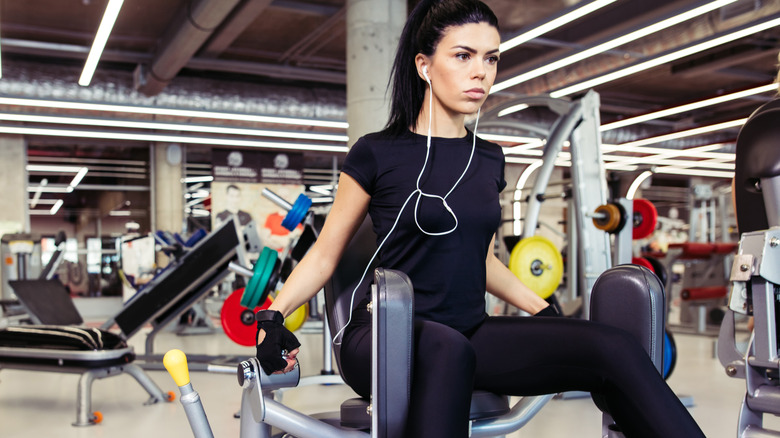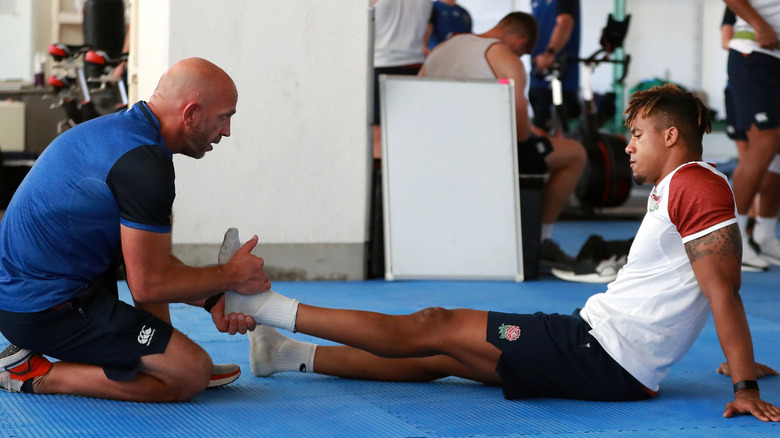Workouts You Can Still Do With A Broken Foot
When you work out regularly, an injury could stop you in your tracks — especially when it's a broken foot. For most workouts, like jogging, Zumba, or strength training, your feet play an important role in keeping you steady, supporting your weight, and helping you move.
With a broken foot in the picture, you might worry that you'll need to stay sidelined for a while until your fracture fully heals. After all, foot fractures can be painful, and not caring for your injury correctly while it heals could delay or prevent healing altogether.
Although you should be careful about what you do when you have a broken foot and always heed your doctor's advice regarding its healing, there may be some workouts you can still do despite your injury. In fact, your doctor may even tell you that moving your foot and ankle carefully once it stops hurting could be a good move for your overall healing (per Merck Manual). The following workouts could still be possible for some people, depending on the extent of their foot injury and doctor's suggestions. As a reminder, we are not medical professionals, so it's always necessary to discuss your specific injury and treatment program with your doctor before trying any of these exercises.
Swimming or aqua jogging
Swimming is a true anomaly of workouts. It's considered one of the best workouts you can do to exercise your entire body because you have to move tons of muscles to work your way through the water. Yet, it's also one of the best for your joints because it doesn't cause an impact on your knees, feet, and ankles like other workouts do.
Because you don't need to stand on your feet when you're in the water, swimming may be an ideal workout to use when you're waiting on your broken foot to heal, barring that your foot is in a cast, of course. In fact, swimming coach Megan Lassen told U.S. Masters Swimming that once her broken foot was cleared to be in a boot, she immediately got back in the water when her doctor said she could remove her boot to swim.
Aqua jogging could also help you get a good workout without doing more damage to your foot. This exercise requires you to mimic the motion of running in the water without letting your feet touch the bottom. Therefore, there's no actual impact to your injured foot, but you still get the benefits of an excellent water workout (via Runners Connect).
Lying-down core workouts
If you are unable to put any weight on your injured foot yet, now might be the best time to work on strengthening your core. The core affects everything from your posture and balance to overall strength and arm and leg muscle coordination. So, it's not a bad thing at all to have some extra time to devote to core workouts while you wait for your foot to heal.
Although some core moves require you to stand up to get full range of motion, there are plenty that you can do while lying on your back and avoiding the use of your foot. For example, one of the most common core exercises are crunches. You can do these by lying down and bending your knees, keeping your feet flat on the floor. Then, put your arms behind your head and tighten your abs, contracting them as you use them to lift your shoulder blades and head off the floor and lowering back down. You can also flip over to your stomach for an exercise known as swimmers. Do these by keeping your legs straight, and extending your arms past your head. Lift your head off the floor and alternate lifting your right arm and left leg, then the left arm and right leg. Be sure to keep your boot while working out if you're instructed to do so by your doctor.
Use a bench press
A bench press is a bench that you can lie down on and lift weights to strengthen the muscles in your arms, chest, and shoulders. Although you don't need to stand on or use your foot when bench pressing, you do need to keep your feet firmly planted on the floor for safety and to maintain the appropriate posture to avoid injury when using a bench press, so be sure to get your doctor's approval first.
If you haven't yet used a bench press, you should also learn the appropriate ways to use the machine so you don't risk any other injuries. It's always important to have another person help and watch over you — also known as a spotter– as you use it. Start with a bar with no weights to understand proper form before moving on to light weights. Draw your belly button toward the bench so that your back lays flat against the bench as you lower and lift the bar. If your gym has personal trainers available, you might consider working with one who can coach you on the basics of benching.
Seated battle rope exercises
Battle ropes are popular for gym workouts, allowing you to strengthen your upper body and core by raising the ropes up and down. Often, people use battle ropes by standing, which offers a full-body workout. However, you can also do your battle rope exercises from a seated position so you won't harm your injured foot, either by using a chair or sitting on the ground. Doing so will still give you an excellent workout for your core and upper body.
Fitness influencer Adrian Bryant offers a full battle rope workout on YouTube with modifications for people who need to stay seated during the workout. One of the most common exercises to do with a set of battle ropes is alternating waves, during which you use one arm to lift a rope while the other arm lowers the other rope, alternating that pattern to create a wave-like rope motion. Try this seated in a chair to give your arms and the ropes plenty of room to make the wave. You can also stay seated as you hold one rope in each hand and bring them across your body from side to side, rotating your abs as you swing the ropes.
Workout with a VR headset
Say what you want about the idea of using virtual reality to work out, but once you try it, you may never want to go back to traditional fitness routines. One VR workout that's taken fitness enthusiasts by storm is Supernatural, a workout game that focuses on boxing routines and Flow, which are dance-like, rhythmic workouts. Both are set to catchy songs spanning several decades, allowing you to move and groove as you get your sweat on.
Although this workout program is traditionally done standing up — there are triangles to help you move back and forth and squat and some workouts with knee strikes for even higher calorie burn — it's also completely plausible to do it seated. In fact, when one member of the Official Supernatural Community on Facebook asked whether others did their workouts sitting down, several members chimed in that they do their workouts this way due to health or physical challenges. If you want to get started with Supernatural and learn how others make their workouts their own even when seated, you should consider joining the group to follow along.
You might be able to cycle in a boot
Depending on the type of fracture you have and how it's being treated, such as with a boot or with a cast, you might still be able to take on cycling as a form of exercise. According to Podiatry Associates, Inc., cycling could be possible to add into your routine once your fracture makes it to a particular point in the recovery process. Of course, this largely depends on the extent of your injury and your doctor's recommendations, so be sure to consult with your doctor first.
If you're wearing a walking boot for a stress fracture, you may need to continue wearing the boot while cycling to ensure that you don't put any additional strain on your injury. And, most importantly, don't overdo it. Slow and steady is the best route to go once you're given the okay to ride so you don't exacerbate your injury (via RNV Podiatry). Running coach Jenny Hadfield suggests in a Runner's World Q&A that you take an indoor cycling class at your gym and tell your instructor about your injury so they can offer modifications for you.
Or, cycle your arms instead
Don't worry if you aren't able to hop on an exercise bike just yet, because there's another way to get some cycling in: the arm ergometer. You can likely find an arm ergometer at a local gym. This machine offers a cardio workout without using your legs by putting your arms into a cycling motion, similar to how you'd cycle your legs using a bicycle. The unique movement allows you to train your upper body while getting your heart rate up and exercising the heart.
Because the arm ergometer puts you in a seated position, you don't need to use your injured foot at all. Simply keep your feet flat on the ground, sit up straight, and adjust the handles to your height and arm length, if needed. Adjustable machines also usually have a tension setting, so you can add more resistance as you get stronger for a more challenging workout.
Pilates workouts
Pilates is similar to yoga in that it's designed to build flexibility, strength, and balance. The workout incorporates muscles from the full body while a person focuses on each movement to learn control and understand what each movement is doing. It's an excellent practice for many injuries, too, as it was originally developed to help dancers work through and prevent injuries.
Pilates can be done using a mat or a machine called a Pilates reformer. The Pilates reformer allows for several exercises you can do while lying down or seated so you don't put excess strain on your broken foot while helping you maintain your posture. For example, you can steer clear of doing any exercises that require you to put your feet in the straps and focus more on upper body strength instead while lying down, sitting, or kneeling on the reformer.
Footwork is a key component of Pilates used to strengthen the feet and ankle muscles (per TODAY). Once you're cleared by your doctor to continue more regular use of your feet, you can ask if doing footwork on the reformer or on your mat could help your specific injury.
Total-body chair workouts
Working out from a seated position can be challenging, but it's far from impossible. And, despite not being able to achieve full mobility from a chair, you can still get a decent workout without having to put weight or strain on your broken foot. According to Medical News Today, chair workouts can increase strength, improve overall mobility, and boost balance and circulation.
Even if your foot is casted or in a boot, it won't affect this type of workout. Find a comfortable chair that doesn't roll or move when you move. Then, mimic some of the exercises you'd typically do with weights or body resistance when standing up. For example, raise your arms up from the sides of your body while drawing up one knee at a time, bringing it to a 90-degree angle. Lower the knee and arms, and repeat with the other knee. You can also target the abs by doing side-to-side crunches or rotating your abdomen with your hands behind your head, like you would when doing a Russian Twist.
Seated weightlifting
Strength training is incredibly important for your overall physical health. Not only does it build muscle, but it can also strengthen your bones, make you more flexible, and target heart health.
If you're used to lifting weights and understand the proper form, you might be able to switch from your usual standing strength exercises to doing them in a seated position instead. Or, get help from a personal trainer so you can avoid getting any new injuries as you exercise. But, because you can sit in a chair and keep weight off your foot, seated weightlifting can be a relatively safe option for a workout.
While seated and your feet firmly placed on the floor in front of you, you can use weights for overhead presses, overhead tricep extensions, bicep curls, and bent-over rows. Chest flys, tricep kickbacks, and front raises are also possible on a chair. Find the exercises you like best and put them in a rotation with several reps of each to get a full workout in.
Yoga using your non-injured foot
On days that you want to work more on balance, strength, flexibility, or mental health rather than cardio and sweaty workouts, you might try yoga instead. The great thing about yoga is that there are so many different moves you can do, and many of them don't require you to use your injured foot. In fact, some only need one foot, like the tree pose, which you may be able to do with your non-injured foot if given the green light by your doctor to participate in yoga.
You can also keep your feet out of your workout altogether by doing seated or lying down yoga poses and movements. For instance, health and fitness coach Caroline Jordan features a full yoga routine on her YouTube channel for people with foot injuries. It avoids all standing movements and, instead, uses the knees and side body to complete several moves and poses that actively engage the core.
Seated cardio
If you're used to being physically active, then we understand that sitting in a chair to work out probably isn't on your radar. Still, as you can see from other suggestions on this list, seated exercises are probably your best bet with a broken foot unless your doctor gives you the green light to put some weight on your foot.
Until then, you should give seated cardio a try. Cardio exercises are any that get your heart rate and breathing rate up, essentially targeting your heart's function and health. And, contrary to popular belief, it doesn't take extremely intense movements for an activity to be considered a cardio workout. If you can make your movements intense enough while seated to boost your heart and breathing rates, you've successfully entered cardio mode.
Think of ways you can implement your usual cardio workouts into a chair routine. Instead of doing standing crunches, for example, you can do them while sitting. Place your hands behind your head and lift one knee as you lower your elbow on the same side to meet your knee. Then, switch to the other side. You can also try alternating toe touches, seated jacks, and cross-body punches with leg lifts.
Circuit training
Circuit training leads you through various types of exercises, usually using different machines or equipment to vary the muscle groups you work. One of the best things about circuit training is that you can personalize your circuit to your needs. Circuit training involves a lot of moves and a lot of different equipment, so you could get a full circuit done without having to use your foot.
Whether you have a home gym stocked with equipment or visit a gym to get your workouts in, you can circuit train to increase your heart rate and get stronger. For example, you can spend a portion of your time at core exercise machines or on a mat to work your abs, back, and hips in seated positions. There are also plenty of upper body exercise machines at gyms to tone and strengthen your biceps, triceps, and shoulders. And, if you want to lift weights, do so from a seated position or use a bench press.
Enlist the help of a physical therapist
The safest way to exercise with a broken foot is to get assistance from a trained physical therapist who understands how to work around a foot injury properly. In fact, your doctor may even suggest this when discussing your treatment and recovery options. Not only can a physical therapist recommend exercises that are safe for you to do with your injury, but they can also help you exercise your foot in the proper stage of recovery to maintain your muscle and strength.
Another benefit is that a physical therapist may be able to help your fracture heal faster so that you can return to your usual workout routine without modifications. Your physical therapist can help you get more range of motion in your foot, increase flexibility, and possibly even help you manage pain from your fracture through targeted exercises. Your physical therapist works with your doctor's treatment plan to ensure that everything they work on with you is safe for your specific injury, helping you get back on the road to your fitness journey.

